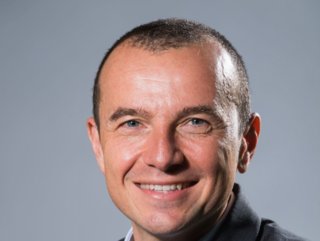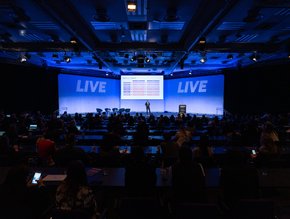Energy is the key to climate action says Schneider Electric

Olivier Blum, Executive Vice President of Schneider Electric’s Energy Management Business talks about the outcomes of the annual global IEA conference that took place in Paris earlier this year, and the critical role energy efficiency will play in solving the energy and climate crises.
Can you tell me about the International Energy Agency (IEA) conference?
This year, Schneider Electric partnered with the IEA for its 8th Annual Global conference on energy efficiency, and it was a truly electrifying experience – pardon the pun. In the gilded halls of Versailles, outside Paris, I joined many other business leaders, policymakers and energy market experts to discuss a topic close to my heart and at the top of the climate agenda: the critical role of energy efficiency in tackling the climate and energy crises. It was three packed days of panels, workshops, and productive conversations that shone light on a topic that deserves the world’s attention.
Why is energy efficiency so important?
Far too often, decarbonisation efforts focus only on energy supply — think replacing gas-fired power stations with renewables like wind and solar. But this is only half of the story.
According to the IEA’s net-zero scenario, its pathway to decarbonise the energy sector (currently responsible for over 80% of global CO2 emissions), one-third of the emission reductions needed this decade must come from consuming energy more efficiently. Fortunately, the role that demand-side energy solutions can play is now more widely accepted — and widely available. The outcomes of the event’s public-private discussions outlined how a fair energy transition, underpinned by energy efficiency, and enabled by digitalisation and electrification, can drive accelerated decarbonisation while also addressing the energy crisis, reducing costs and increasing security of supply.
Can you tell me more about the Versailles 10x10 Actions?
The Versailles 10x10 Actions are a set of priorities needed to accelerate our efficiency and decarbonisation journey. None of the Actions can be delivered without first measuring and diagnosing current efficiency levels. For years, we have understood the efficiency of our cars but we don’t see this for our homes or buildings, despite the fact that it can be done relatively easily and inexpensively. We need to digitise consumption, connect and report in app for outcome-based performance. The power of digital innovation is crucial to visualise and act on energy waste.
Advanced energy management systems are widely available today and allow users to see and control the performance of every connected appliance within a home, an office, or an industrial facility. This birds-eye view of energy consumption offers the biggest potential to identify and eliminate waste.
Software systems built on AI algorithms help optimise how and when to consume, produce and store energy. In the absence of extensive grid upgrades, digital-enabled energy management systems connecting homes, offices, and other facilities with power grids are key enablers for resiliency and efficiency.
What skills will people need to deliver the Actions?
People increasingly want to do ‘something’, but they don’t know what. Sharing practical applications, one-stop-shop advisories, and lighthouse examples enable learning from best-in-class, real-life net zero homes, buildings and industries.
One of the topics that kept coming up at the IEA conference and one that is not to be underestimated is training people to have the right skills. Upskilling, reskilling and increasing resources will be critical to enable the energy transition. Action and discussion to-date has largely been about new construction, but the biggest impact will come from retrofitting, and this will require a large-scale mobilisation of expertise.
Training people with the skills to drive the transition will have the added bonus of stimulating job creation and delivering wider social and economic benefits. The biggest opportunities will be in emerging and developing economies. As the demand for energy efficiency grows, so does the need for a digitally skilled workforce to install, operate and service these connected systems. Electricians need to become software and smart tech experts, plumbers need to understand electrical installations for heat pumps. The transition will require a rapid evolution and expansion of skills.
How cost effective is energy efficiency?
As the Versailles 10x10 Actions state, there is a mentality shift needed from designers/architects and decision makers away from cost of construction and towards a project’s total cost of ownership (TCO). Construction typically represents around 20% of total cost, meaning much more thought needs to be given to the operation and maintenance of a building, with massive opportunities for efficiency.
Investment in energy efficiency has a very short, but also recurring payback, meaning continued savings well beyond ROI. Investment usually means cost, but efficiency is investing to remove cost, with green capital expenditures (CAPEX) effectively saving brown operating expenditures (OPEX). Financing models need to be optimised to recognise and support this.
What role do governments play in leading the energy transition?
The United Nations Environment Program estimates that buildings produce around 40% of global carbon emissions. The IEA has measured that energy efficiency, electrification and low-carbon energy have the potential to reduce more than 95% of these emissions by 2050.
While the onus to act is on every individual and organisation, particular responsibility falls on governments as they generally own huge property and infrastructure portfolios.
Companies are demonstrating increasing commitments towards net zero (the number of organisations signing up for the Science Based Targets Initiative, or SBTi, has been doubling year-on-year since 2018). The significance of government portfolios means they have a clear responsibility to become role models and demonstrate leadership in this area. According to the Versailles 10x10 Actions, this starts by creating a decarbonisation roadmap, in which companies audit each building’s energy performance and carbon impact to then strategise, digitise and decarbonise.
One example of a successful civic energy efficiency project is Schneider Electric’s partnership with Madison County School District in Alabama, USA. Here, district-wide energy-efficient lighting, heating, ventilation, and air conditioning are reducing energy costs by 40%. Over two decades, the district will have saved $40 million, more than paying for building control systems and future efficiency projects.
What are the best solutions to prioritise today?
There was a large consensus amongst attendees at the IEA conference that incentives are more effective than coercion (carrot vs stick), but when coercion is needed, there must be a horizon that allows people to review, plan and adapt for their transition.
When we hear examples of seven-year wait times to get new renewable infrastructure physically connected to the grid, clearly this is not acceptable. The time to bring green electricity online needs to be accelerated, with transmission lines made available much faster.
When it comes to tackling climate change, there has been a widespread tendency to revert to ‘big ideas’ or ‘silver bullets’ that are years away. Perhaps it’s human nature to want what we don’t have? The reality is that reliable, efficient and inexpensive solutions already exist, so we need to focus on adopting existing technology faster. Consider that around 60% of building emissions come from heating, but only 2% of homes have thermostats. We must tackle the biggest stakes today, deploy what we have, at scale, and start with the cheapest solutions.
The Versailles 10x10 Actions stress the need to aim for net zero construction everywhere, whether that be the huge new construction coming in emerging economies, or the ongoing construction in developed economies. In all cases, we must leverage existing, available technology for net-zero new builds.
What message can organisations take away from the Versailles 10x10 Actions?
With the climate crisis getting more severe, as we’ve seen with recent heatwaves in Greece and wildfires in Maui, we don’t have any time to waste. Today, energy efficiency is the fastest and least expensive solution to driving decarbonisation. The Versailles 10x10 Actions represent the commitment of 45 governments to double average global rate of energy efficiency improvements by 2030. Now, we must enforce these measures and implement the technologies to improve energy efficiency in all functions of society. This is the only way for demand-side improvements to come to fruition and tackle the climate crises for good.
******
For more energy insights check out the latest edition of Energy Digital Magazine and be sure to follow us on LinkedIn & Twitter.
You may also be interested in Sustainability Magazine and EV Magazine.
*********************************************
BizClik is a global provider of B2B digital media platforms that cover Executive Communities for CEOs, CFOs, CMOs, Sustainability Leaders, Procurement & Supply Chain Leaders, Technology & AI Leaders, Cyber Leaders, FinTech & InsurTech Leaders as well as covering industries such as Manufacturing, Mining, Energy, EV, Construction, Healthcare + Food & Drink.
BizClik – based in London, Dubai, and New York – offers services such as Content Creation, Advertising & Sponsorship Solutions, Webinars & Events.






